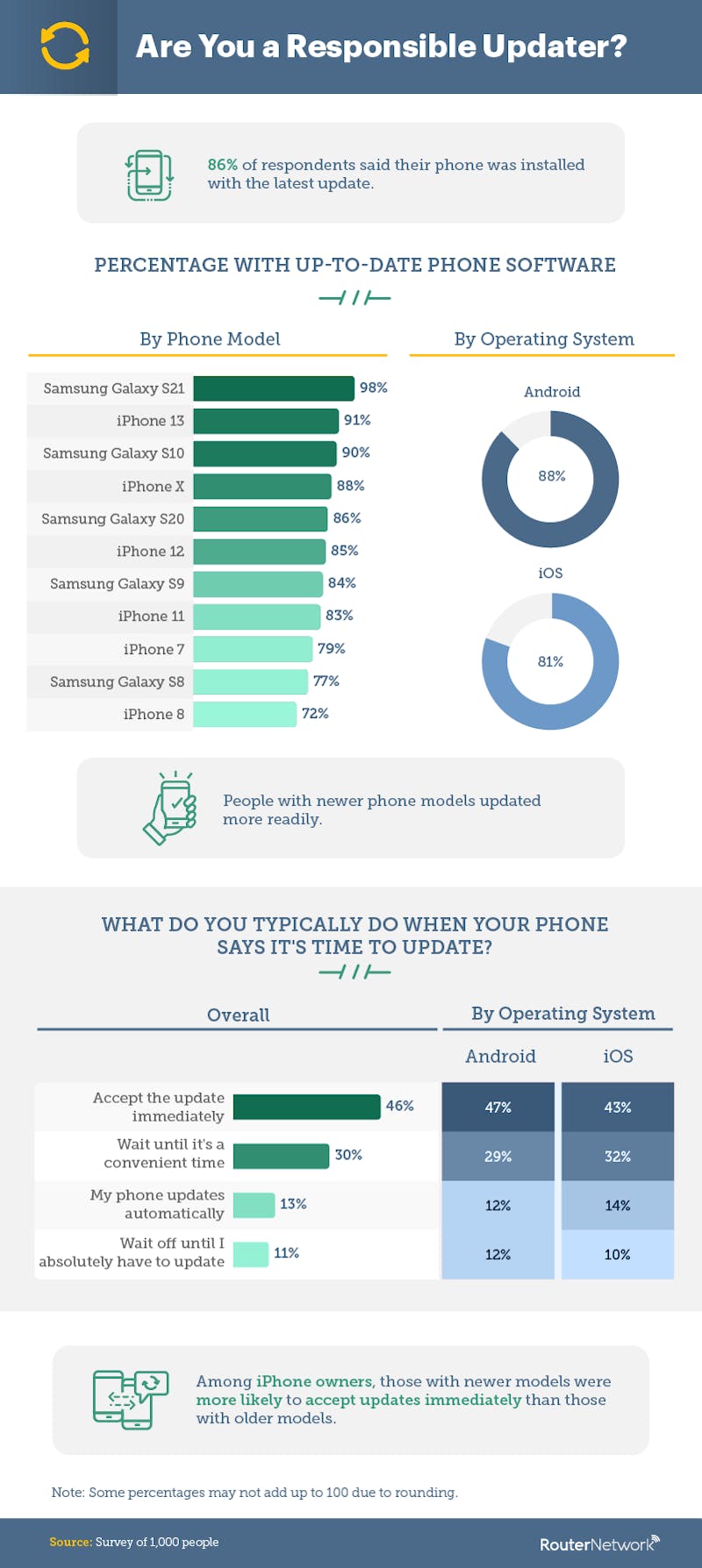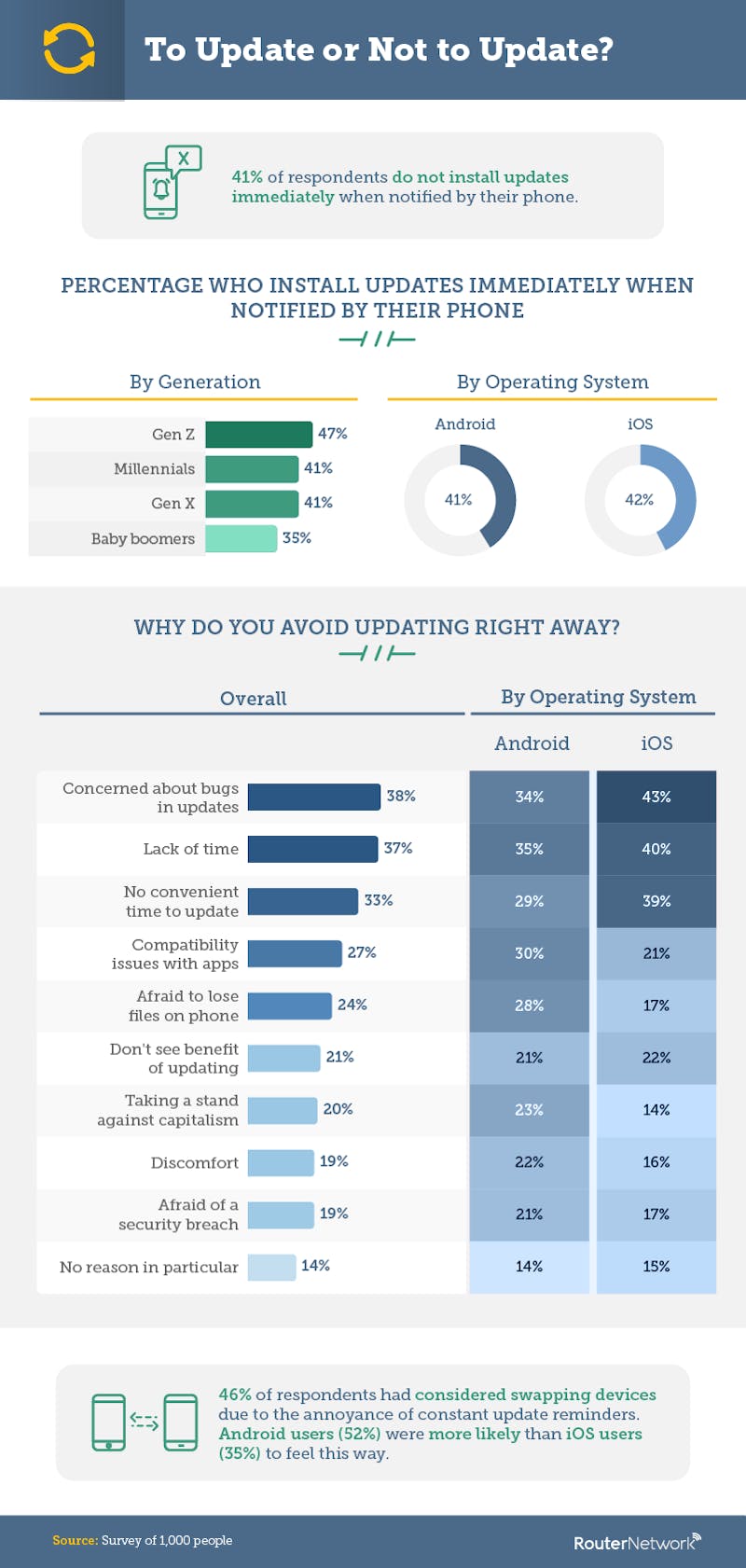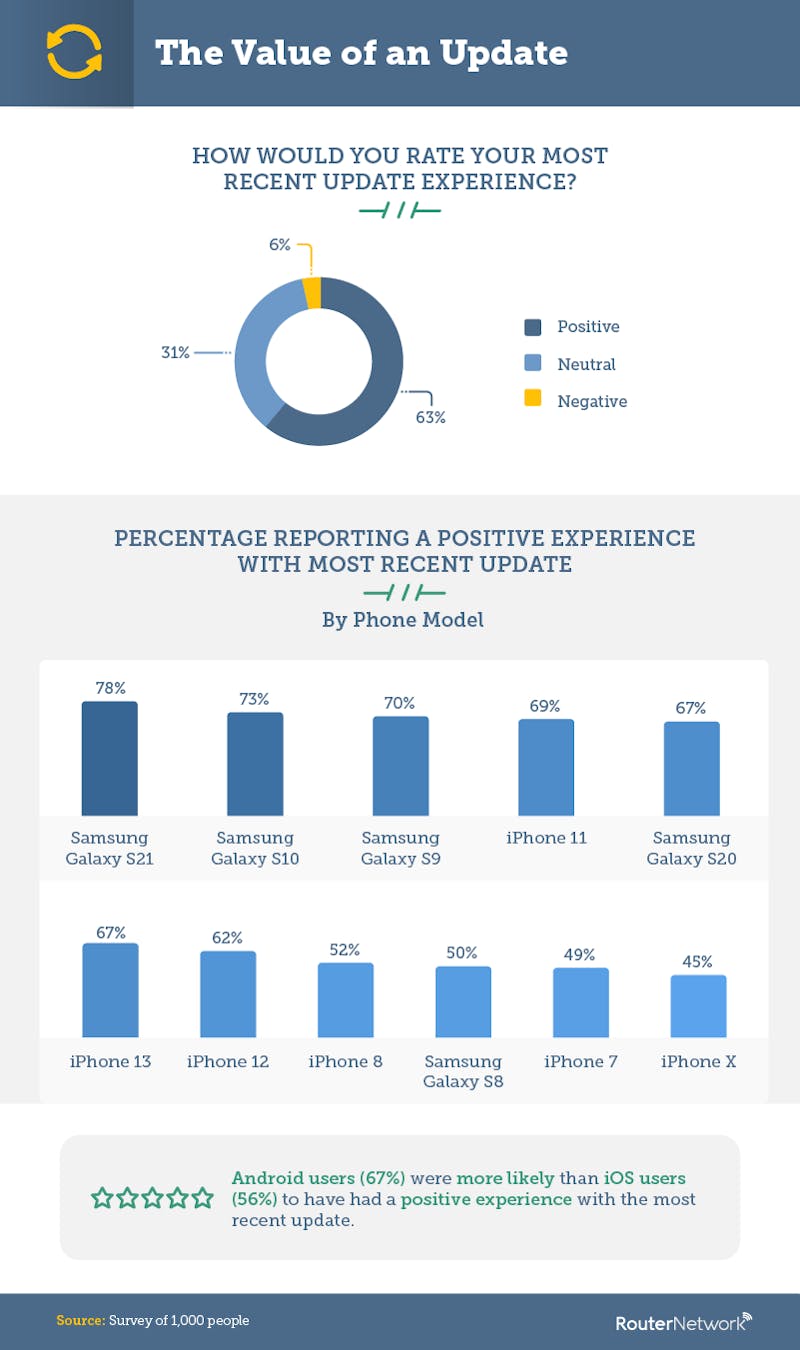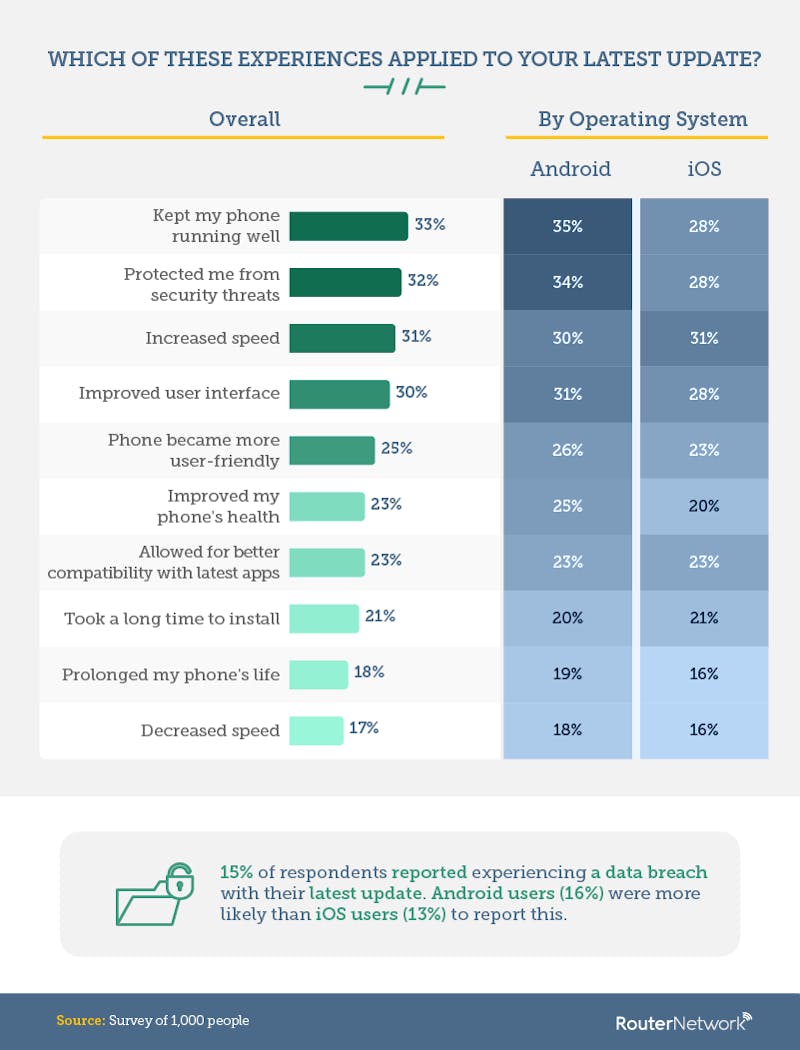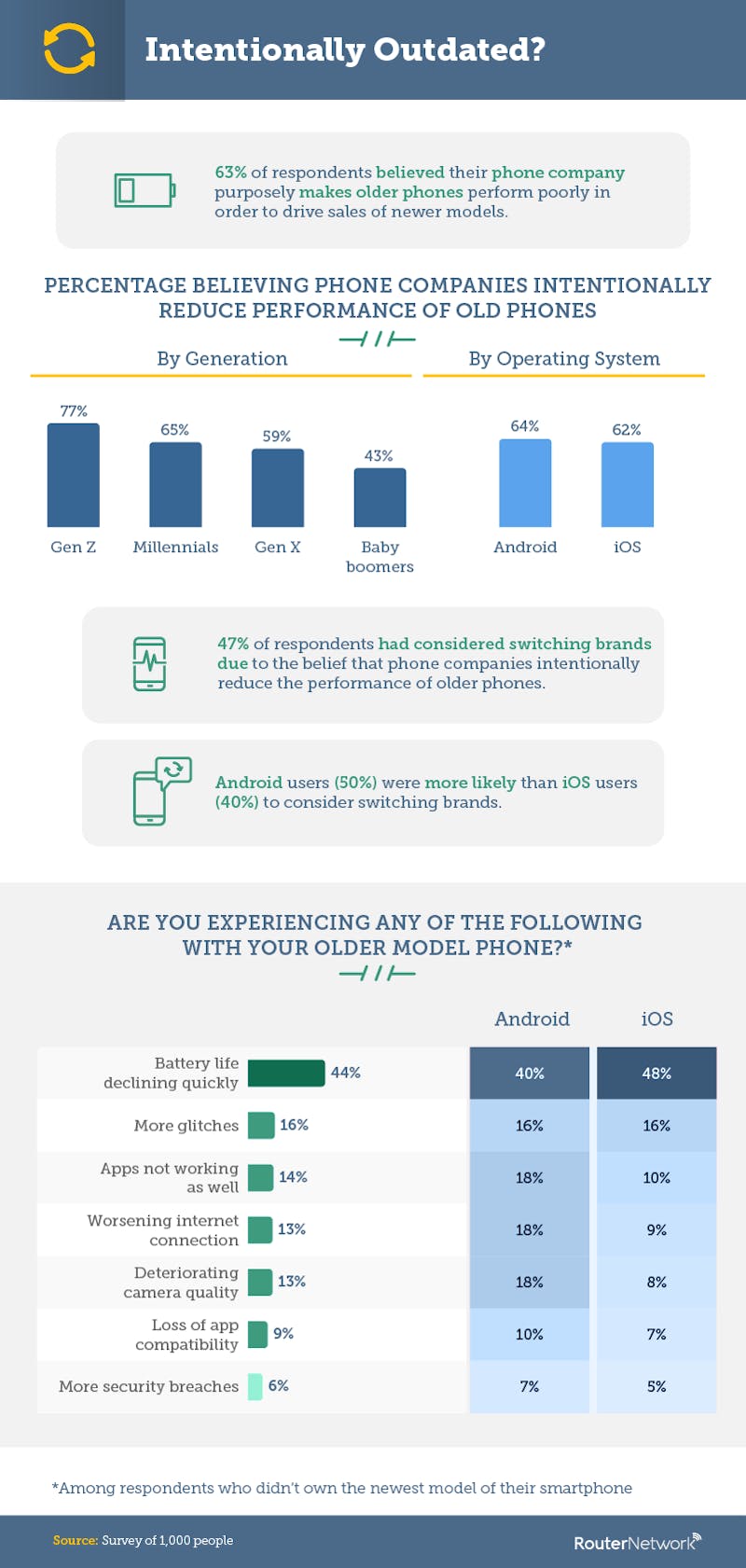Putting Off Device Updates

Why Aren’t You Updating Your Phone? [Survey]
Key Takeaways
- Sixty-three percent of people believed phone companies purposely slow down old phones to drive sales of newer models.
- Gen Zers were the most likely not to update their phones immediately.
- Fifteen percent of respondents reported experiencing a data breach with their latest update.
- Android users (50%) were more likely than iOS users (40%) to consider switching brands.
In today’s “need to know it now” world, very few individuals are without a mobile device of some sort. According to the latest research on smartphone market share covering the third quarter of 2021, Samsung has 20% of the worldwide market share, followed by Apple with 14%. And, what started as handheld mobile phones are now mini-computers with more capabilities than were available to NASA engineers for Apollo space missions.
The “brains,” or what allows a smartphone to be smart, is the operating system (OS). Samsung uses the Android OS, while Apple’s is called iOS. When we look at the worldwide mobile OS market share also released in November 2021, Android captures 70.75% of the market, with iOS commanding 28.53%. However, when looking at the U.S. OS market share for the same period, iOS comes out on top with 58.45% to Android’s 41.23%.
With so much computing power and capability in a single smartphone, software creators are constantly tasked with improving operating efficiency and battery life. To accomplish this, smartphone OS developers use updates. Most smartphones, including Samsung and Apple, give users the option of allowing phones to install updates automatically. However, most users choose to install updates at their convenience. The question is, do end-users install updates as often as they should or procrastinate until devices underperform?
We surveyed 1,000 smartphone users to gauge when and how they handle device updates. Follow us for the next few minutes to examine how respondents feel about mobile device updates.
Updates Are Available
Both Samsung and Apple smartphones notify users when new OS updates are ready to install. But just because users receive a notification doesn’t mean they immediately hit the “install now” button.
Each fall, smartphone users anticipate the release of new models. Samsung’s latest model is the Galaxy S21 series, while Apple introduced the iPhone 13 earlier this year. Users with devices that are two years old or newer updated the most, and Android users updated slightly more frequently than iOS users. Practically all Samsung Galaxy S21 users had the latest OS system installed – 98% to be exact. iPhone 13 users were only slightly behind at 91%. Overall, 86% of our respondents’ devices were installed with the most recent update.
For years, users have debated the merits of Google’s Android OS versus Apple’s iOS. One of the differences is that Apple produces its own hardware and software. In contrast, Samsung, HTC, Motorola, and other minor phones use Android. The “which is better” issue often comes down to user preference. On average, Apple issues more frequent updates than Android.
The quality of smartphones is also constantly improving, theoretically enabling users to keep them for longer. However, we found that just over a fifth of our respondents traded or upgraded their phone every year or less. Slightly over half kept theirs for one to two years, while 20% had had the same device for three to four years. A mere 6% had had their phone for five years or longer.
So who updates immediately, and who procrastinates before installing updates? Those that update immediately accounted for 46% of respondents. Another 30% reported waiting until a time convenient to them. Thirteen percent may not even realize an update has occurred because their devices update automatically, while the remaining 11% didn’t take action until they absolutely had to.
Fifty-seven percent of our respondents considered themselves “tech-savvy,” and naturally, all of these people reported updating their devices when immediately available.
OS Decision Time
“Update Available,” reads the notice on your smartphone. Some OS updates are simple and take only a few seconds. Other updates can eat up valuable time, keeping you from receiving important calls, text messages, or “likes” from your social media followers.
OS updates are designed to improve a device’s speed and functionality; but sometimes, new updates contain bugs that cause the opposite effect—which is why 38% of all survey respondents were reluctant to update immediately.
For others, time was the primary issue. Thirty-seven percent of respondents indicated that updating a smartphone takes too long. Between reading news feeds, checking investment account balances, or trying to book a vacation, another 33% simply can’t find a convenient time to update their device. IOS users were slightly more hesitant than Android users to immediately update their devices for all three reasons listed above.
However, Android users were more hesitant than iOS users to download new device updates for other reasons. Compatibility issues with different apps was a major worry for 30% of Android users, compared to 21% of iOS users. Similarly, fear of losing files during or after an update concerned 28% of Android users but only 17% of iOS users.
Another 23% of Android users said they are protesting against capitalism by stalling the update process, while 22% of the same group said they’re simply uncomfortable updating immediately. A similar percentage voiced concern about security breaches. Apple users, however, were less concerned about all three of these issues.
Given our respondents’ tendency to change phones regularly, it’s unsurprising that 46% of them had considered switching phones rather than dealing with continuous update alerts. However, Android users were far more likely to feel this way than iOS users (52% versus 35%, respectively).
What about generational differences? The top concern for 39% of baby boomers was potential bugs. This issue also worried 42% of Gen Zers and 40% of millennials. The most significant problem for Gen Xers was not having the time to update. When it came to resisting updates as a form of protest against capitalism, 25% of Gen Zers adopted this approach, compared to just 8% of baby boomers.
Experience Counts
Despite the inconvenience of updating one’s smartphone, 63% of people reported an overall positive experience. However, the type of device being updated appeared to make a difference.
Per our respondents, the newer the device, the better the update experience. Samsung Galaxy S21 users were the most likely to report a positive experience at 78%, with Galaxy S10 and S9 users right behind. Apple iPhone 11 users were slightly more likely than S20 users to report a positive upgrade experience, however, even topping iPhone 13 owners by a slim margin of 69% to 67%, respectively.
When asked to be more specific about what made their experience a positive one, over a third of Android users said their latest update had kept their phone running well. Other top benefits included receiving added protection from security threats and an improved user interface. For iOS respondents, the most commonly cited benefit was a device that ran faster (31%). Respectively, 28% of Apple owners also reported that the update kept their phone running well, protected them from security threats, and improved user interface.
Almost all smartphone users worry about security breaches, with both Android and iOS apps a concern for security experts. In recent years, Android’s reputation has taken a hit for not providing a high enough degree of security. On the flip side, Apple makes attacking a device through apps harder. Still, it’s also more difficult to “lockdown” or protect an iPhone. Among our respondents, a total of 15% experienced a data breach with their most recent update, with a slightly higher percentage of Android users than iOS users saying so.
Security experts say there are several steps Android and iOS users can take to secure their phones, and one is to update software regularly. The tactics used by cybercriminals to exploit devices and apps keep evolving. Therefore, software engineers constantly work to provide safer updates. Other recommendations are to only download apps from Google and Apple stores, be mindful of app permission requests, and only use a virtual private network (VPN) on public Wi-Fi networks.
A Slowdown Conspiracy
Several years ago, smartphone owners began to express frustration that with every OS update, their device ran slower. Users started pointing fingers at Android and Apple, saying slowdowns were intentional and designed to force users to trade up for newer, more expensive models.
Almost two-thirds (63%) of respondents believed phone manufacturers implement an intentional slowdown strategy. In 2017, Apple admitted to slowing down older phones with new software updates and settled a series of class-action lawsuits. According to Apple, older devices may experience decreased battery life because the latest updates require more battery capacity. However, as tech devices age, they tend to run slower for many reasons, including the user running too many apps or programs, limited storage space, a battery that needs replacing, or an outdated operating system.
Just under half of Apple users complained of declining battery life, slightly more so than Android users. When broken down by generation, 77% of Gen Zers were convinced that device manufacturers intentionally slow down older phones, followed by 65% of millennials and 59% of Gen Xers. Baby boomers were the least suspicious of a phone slowdown conspiracy, with only 43% believing in it. The perceived conspiracy made 47% of all respondents think about switching phone brands, with Android users slightly more open to doing so than iOS users.
How users with particular phone models feel about the existence of a conspiracy varied slightly. Samsung Galaxy users topped the list—76% believed in intentional slowdowns. IPhone 13 and 12 users followed closely at 71% apiece. At the bottom of the list were Samsung Galaxy S8 and S9 users.
Protect Yourself
In today’s world of high-speed internet, staying connected has never been easier, but getting connected can be another story. At Router Network, we have all the latest news and tips you need to keep your devices operating smoothly and efficiently. From our site you can check your port connection, IP address or even your internet service provider with the click of a button. Check out some of our other articles to boost your internet IQ today.
Methodology and Limitations
We surveyed 1,000 smartphone users to explore their sentiments on phone updates. Among them, 60% were men, and 40% were women. For short, open-ended questions, outliers were removed. To help ensure that all respondents took our survey seriously, they were required to identify and correctly answer an attention-check question.
For operating system breakdowns, the sample sizes were:
- iOS: 362
- Android: 623
- Other operating systems: 15
Survey data have certain limitations related to self-reporting. These limitations include telescoping, exaggeration, and selective memory. We didn’t weight our data or statistically test our hypothesis. Our margin of error was +/- 4% with a 95% confidence interval.
Fair Use Statement
If the information regarding system updates in this article is beneficial to your readers, by all means, please share it for any noncommercial purpose. We only have one small request: Please link back to the original write-up to provide credit where it’s due.
